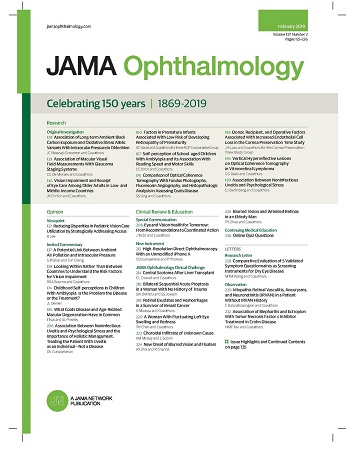Peripheral Iridectomy With Goniosynechialysis and Goniotomy vs Trabeculectomy for Advanced PACG: A Randomized Clinical Trial.
IF 7.8
1区 医学
Q1 OPHTHALMOLOGY
引用次数: 0
Abstract
Importance The safety and effectiveness of combining surgical peripheral iridectomy (SPI) with goniosynechialysis (GSL) and goniotomy (GT) vs trabeculectomy for intraocular pressure (IOP) reduction remains unknown. Objective To investigate the safety and effectiveness at 1 year of SPI + GSL + GT vs trabeculectomy in advanced primary angle-closure glaucoma (PACG) without cataract. Design, Setting, and Participants This noninferiority randomized clinical trial was conducted at 8 tertiary eye centers in China. A total of 88 Chinese patients (88 eyes) with advanced PACG without cataract were enrolled from January 2022 to July 2023. Data were analyzed from August 2024 to September 2024. Mean (SD) patient age was 60.3 (7.3) years, and 52 patients (59.1%) were female. Forty-three patients were randomized to SPI + GSL + GT and 45 were randomized to trabeculectomy; 86 patients (97.7%) completed the 12-month follow-up. Interventions Participants were randomized 1:1 to receive SPI + GSL + GT or trabeculectomy. Main Outcomes and Measures The primary outcome was IOP at 12 months (noninferior margin: 4 mm Hg). Secondary outcomes included surgical success (IOP: 5-18 mm Hg, ≥20% reduction from baseline, with or without antiglaucoma medications); postoperative complications and interventions, including bleb massage, suture lysis, or releasable sutures; and number of antiglaucomatous medications prescribed. Results At 12 months, the SPI + GSL + GT group had a mean (SD) IOP of 15.6 (4.0) mm Hg vs 14.9 (4.2) mm Hg in the trabeculectomy group (difference, 0.5 mm Hg; 95% CI, -1.2 to 2.2; P = .55), which was within the 4-mm Hg noninferiority margin. Qualified success rates were 38 of 43 participants (88.4%) for SPI + GSL + GT and 42 of 45 participants (93.3%) for trabeculectomy (difference, -5.0%; 95% CI, -19.6% to 8.5%; P = .48). However, complete success rates were lower in the SPI + GSL + GT group (26 participants [60.5%]) vs the trabeculectomy group (37 participants [82.2%]; difference, -21.8%; 95% CI, -40.2% to -2.4%; P = .03). Postoperative complications were present for 8 participants (18.6%) in the SPI + GSL + GT group vs 9 participants (20.0%) in the trabeculectomy group (difference, -1.4%; 95% CI, -17.9% to 15.1%; P = .71). Postoperative interventions were lower in the SPI + GSL + GT group (3 participants [7.0%] vs 25 participants [55.6%]; difference, 48.6%; 95% CI, 32.2%-65.0%; P < .001). Median (IQR) numbers of medications used decreased from 2 (0-3) to 0 (0-1) in the SPI + GSL + GT group and from 2 (2-3) to 0 (0-0) in the trabeculectomy group (difference, -0.81; 95% CI, -1.36 to -0.26; P = .004). Conclusions and Relevance In this randomized clinical trial among patients with advanced PACG without cataract, SPI + GSL + GT demonstrated noninferiority (4-mm Hg margin) to trabeculectomy for IOP at 12 months, with fewer interventions (including bleb massage, suture lysis, or releasable sutures) but no difference in postoperative medication use. This suggests SPI + GSL + GT as a potential alternative to trabeculectomy for similar cases, pending validation in larger sample sizes with smaller noninferiority margins. Trial Registration ClinicalTrials.gov Identifier: NCT05163951.末梢虹膜切除术伴性腺协同术和性腺切开术vs小梁切除术治疗晚期PACG:一项随机临床试验。
手术周围虹膜切除术(SPI)联合角膜协同分析(GSL)和角膜切开术(GT)与小梁切除术降低眼压(IOP)的安全性和有效性尚不清楚。目的探讨SPI + GSL + GT与小梁切除术治疗晚期原发性闭角型青光眼(PACG) 1年的安全性和有效性。设计、环境和参与者本非劣效性随机临床试验在中国8个三级眼科中心进行。在2022年1月至2023年7月期间,共有88名中国晚期PACG无白内障患者(88只眼)入组。数据分析时间为2024年8月至2024年9月。患者平均(SD)年龄为60.3(7.3)岁,女性52例(59.1%)。43例患者随机分为SPI + GSL + GT组,45例随机分为小梁切除术组;86例(97.7%)患者完成了12个月的随访。干预措施:参与者按1:1随机分组,接受SPI + GSL + GT或小梁切除术。主要结局和测量主要结局是12个月时IOP(非下缘:4mmhg)。次要结局包括手术成功(IOP: 5-18 mm Hg,较基线降低≥20%,使用或不使用抗青光眼药物);术后并发症和干预措施,包括水泡按摩、缝线溶解或可释放缝合线;抗青光眼药物的处方数量。结果12个月后,SPI + GSL + GT组的平均(SD) IOP为15.6 (4.0)mm Hg,小梁切除术组为14.9 (4.2)mm Hg(差异为0.5 mm Hg;95% CI, -1.2 ~ 2.2;P = 0.55),在4毫米汞柱非劣效性范围内。43例SPI + GSL + GT患者中有38例(88.4%)成功,45例小梁切除术患者中有42例(93.3%)成功(差异为-5.0%;95% CI, -19.6% ~ 8.5%;p = .48)。然而,SPI + GSL + GT组(26例[60.5%])的完全成功率低于小梁切除术组(37例[82.2%]);差异,-21.8%;95% CI, -40.2% ~ -2.4%;p = .03)。SPI + GSL + GT组有8例(18.6%)患者出现术后并发症,小梁切除术组有9例(20.0%)患者出现术后并发症(差异-1.4%;95% CI, -17.9%至15.1%;p = .71)。SPI + GSL + GT组的术后干预较低(3例[7.0%]vs 25例[55.6%]);差异,48.6%;95% ci, 32.2% ~ 65.0%;p < 0.001)。SPI + GSL + GT组使用药物的中位数(IQR)从2(0-3)降至0(0-1),小梁切除术组从2(2-3)降至0(0-0)(差异为-0.81;95% CI, -1.36 ~ -0.26;p = .004)。结论和相关性在这项无白内障的晚期PACG患者的随机临床试验中,SPI + GSL + GT在12个月的IOP小梁切除术中表现出非效性(4毫米汞柱边缘),干预较少(包括水泡按摩,缝线溶解或可释放缝线),但术后药物使用没有差异。这表明SPI + GSL + GT作为类似病例小梁切除术的潜在替代方案,有待于更大样本量和更小非效性裕度的验证。临床试验注册号:NCT05163951。
本文章由计算机程序翻译,如有差异,请以英文原文为准。
求助全文
约1分钟内获得全文
求助全文
来源期刊

JAMA ophthalmology
OPHTHALMOLOGY-
CiteScore
13.20
自引率
3.70%
发文量
340
期刊介绍:
JAMA Ophthalmology, with a rich history of continuous publication since 1869, stands as a distinguished international, peer-reviewed journal dedicated to ophthalmology and visual science. In 2019, the journal proudly commemorated 150 years of uninterrupted service to the field. As a member of the esteemed JAMA Network, a consortium renowned for its peer-reviewed general medical and specialty publications, JAMA Ophthalmology upholds the highest standards of excellence in disseminating cutting-edge research and insights. Join us in celebrating our legacy and advancing the frontiers of ophthalmology and visual science.
 求助内容:
求助内容: 应助结果提醒方式:
应助结果提醒方式:


